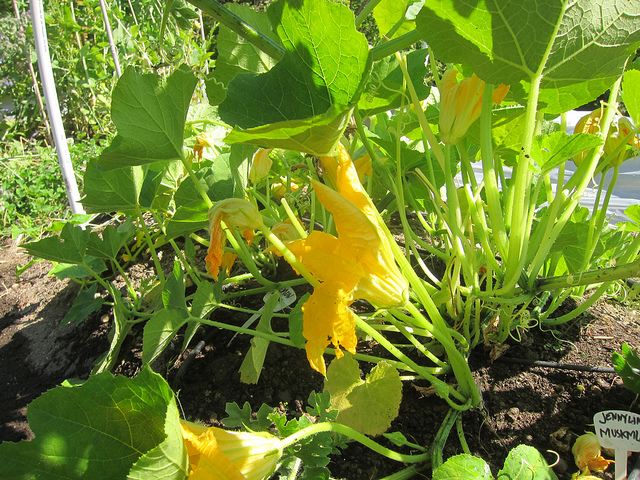HOW TO :: IDENTIFY, HARVEST & COOK SQUASH BLOSSOMS
 One of the most frequently asked questions I get every summer is when and how to harvest squash blossoms. These brilliant tangerine-colored flowers can be cooked in broths, sautéed, or more commonly stuffed and dipped in light batters and fried. Every- one loves fried squash blossoms!
Summer squash plants (all members of the Cucurbitaceae family, for that matter— cucumbers, pumpkins, melons, gourds, and so on) send out both male and female blossoms. Through pollination, male blossoms lend their pollen to the female blos- soms, and those female blossoms turn into the fruit of the plant. A plant will create more male blossoms than are necessary for pollination, and some of these may be harvested and eaten. (But if you eat all of the male blossoms, you will not have any fruit to harvest!)
One of the most frequently asked questions I get every summer is when and how to harvest squash blossoms. These brilliant tangerine-colored flowers can be cooked in broths, sautéed, or more commonly stuffed and dipped in light batters and fried. Every- one loves fried squash blossoms!
Summer squash plants (all members of the Cucurbitaceae family, for that matter— cucumbers, pumpkins, melons, gourds, and so on) send out both male and female blossoms. Through pollination, male blossoms lend their pollen to the female blos- soms, and those female blossoms turn into the fruit of the plant. A plant will create more male blossoms than are necessary for pollination, and some of these may be harvested and eaten. (But if you eat all of the male blossoms, you will not have any fruit to harvest!)
Identifying male versus female blossoms is a reasonably simple task. Male flowers have stamens—a long, slender “stalk” that runs up the center of the bloom, tipped with a thick carpet of pollen. Male blossoms grow on long, thin stems from the base of the squash plant—typically about six or seven inches in length. By contrast, female blos- soms sit low to the plant and do not have a stamen. To harvest, cut the male blossoms at the base of their stems, as close to the plant as possible. You can use the stem in your cooking or trim it down to a few inches. (You may also harvest female blossoms, if you are trying to reduce the fruit of the plant or it’s early in the season and you wish for the plant to fully establish itself before fruiting.)
Use harvested squash blossoms right away, as they wilt quickly. If you need to store them for a short time, line a storage container with a linen cloth or paper towel and mist it until just damp. Lay out the flowers in single layers, leaving space between the blossoms, and stack them between layers of moistened towel. Store in the fridge for up to two days.
To prepare squash blossoms for cooking, I like to remove the stamen, particularly if the anther is thick, as it can taste quite bitter. (The anther is the tip of the stamen and contains the pollen.) To do this, use a small paring knife and delicately open the blossom to remove the stamen at its base or as close to the base as possible. Cook squash blossoms by dipping them into a light egg batter and frying, briefly, in a shallow pool of oil. Make sure the heat is high, as they cook quickly and you need only let the batter brown slightly before serving. For more crunch, roll them in bread crumbs (after dipping them into the batter) before frying.
You can also chop squash blossoms and add them to soups, such as Ricotta– Squash Dumpling Soup or Carrot Peel Soup. I have also had squash blossoms in a simple, light quesadilla. Heat a tortilla in a dry pan; when both sides are golden, add cheese and several squash blossoms to one side and fold in half, pressing the sides together. The cheese will melt and the blossoms will steam. Delicious!
[This article has been excerpted from FRESH PANTRY, so if you're looking for more tips & tricks for eating, growing and living seasonally, please check out my book!]
